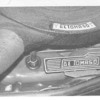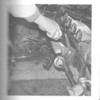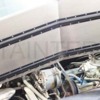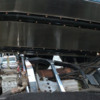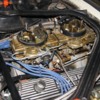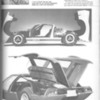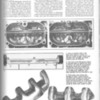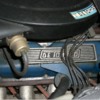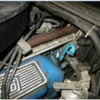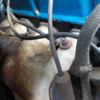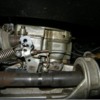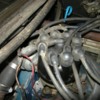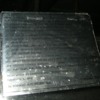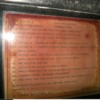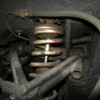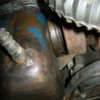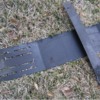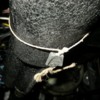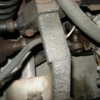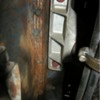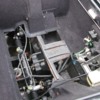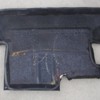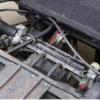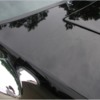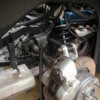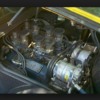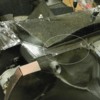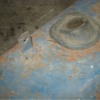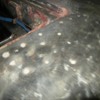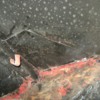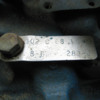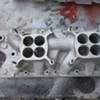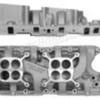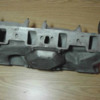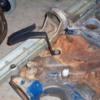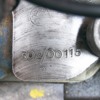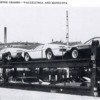Replies sorted oldest to newest
What is the item marked 1003 next to the voltage regulator? Are there any numbers on the voltage regulator?
PM sent
quote:What is the item marked 1003 next to the voltage regulator?
That is the ignition coil.
John
Nonoriginal spark plug wires?
Is that an Autolite 4300? Is it facing the correct way -my (presubably incorrect autolite 4100) carb has throttle linkage facing the other side of the car?
Is that a light next to the voltage regulator- it looks like the one in my front trunk
I am somewhat surprised at the carb alignment (my car's autolite is long gone) but the fuel feed should be in front. Will have to pull vintage magazine pics.
Johnny
quote:Originally posted by LeeA:
another angle...
The carb is backwards. On that carb the choke is on the passenger side.
I looked thru all my old mags, none have the air cleaner off for pics.
quote:Originally posted by Denis C:
Doug, The main concern would be more the fuel line runs on the intake and may cause vapor lock and the pedal cable is crossing over. I wouldn't think DeT would pull the carbs and flip them.
I looked thru all my old mags, none have the air cleaner off for pics.
Really? Well guess what, the throttle lever on the carb on the Mustang is on the drivers side. The throttle rod pulls it back towards the driver.
The choke plate is on the primaries, which are in the FRONT of the carb. That carb is backwards.
I just learned something here about the Mangusta, provided that is an original setup. The carb is mounted reversed. Probably for the throttle cable linkage?
Look at the throttle return spring bracket on the valve cover. That's not stock Ford.
Does anyone have vintage pictures that show that bracket location on the valve cover also, even if the carb can't be seen in the picture? That would tend to indicate that these are original set up, no?
Very interesting set up.
Now having said all of that, the quantity of "original" US Mangusta engine pictures I've seen counting these two...is two.
NOW I'M INTERESTED in seeing more "original" pics too!
I've been combing the net for pictures too and apparently they are as scarce as hens teeth.
There are a couple with the air cleaners on but that doesn't settle much?
I can almost believe that this "backwards" carb is the original setup. I purchased a 1969 4300 carb to put into my car, and I was disappointed to find out that it would not fit in the standard way as the shaft bracket is in the way. There is no way to mount it in the traditional way without moving or removing the shaft and shaft bracket. I didn't think of putting the carb in backwards, but it would probably fit that way in a Mangusta. IF the autolite 4300 is the correct Mangusta carb, I think this is possible.
quote:Originally posted by vyprgt2:
combing the provamo website, I found two other Mangustas (with vins about 30 and 60 higher than Lee's car), that also has throttle linkage on the passenger side of the car. One has the exact same spring bracket on the valve cover!
By the way, does anyone know of any vendor that sells Mangusta tire pressure stickers for the drivers side door?
Can you post those pictures here or at least post a link to them? I'd like to see those also.
To answer DenisC, yes, I can believe Detomaso did this, i.e., mounting the carb backwards. It is a simple solution to what would otherwise be a complex problem.
vvv here is a scan from Petersens "Complete Ford Book" dated 1972.
It is from an article about modifying the engine in a Mangusta. There are no details given about the car itself such as the serial number, owners name, or model year.
This is the passenger side valve cover. I don't see the extra tab on it for the throttle return spring that is shown in the above picture, for the reversed carb.
Attachments
That exhaust manifold looks like a "log type header" to me, like that shown for the Longchamp.
I have seen pictures where the stock Ford 302 cast iron log exhaust manifold is shown on the 'goose..
Found the discussion of 'goose headers here. http://pantera.infopop.cc/eve/...50045562/m/624103536
I think that what is happening is that there are going to be variations on the Mangustas as far as these kinds of details.
Good luck on trying to document anything as "factory original" on these cars.
Attachments
I tried last night to post photos from the provamo website, not sure it is possible, but will try again.
Can you tell from the photo in the book that was scanned if the spark plug wires say autolite and "radio resistance" as per correct Ford wiring of the time?
quote:Originally posted by vyprgt2:
Interesting vintage photos- I had not seen those.
I tried last night to post photos from the provamo website, not sure it is possible, but will try again.
Can you tell from the photo in the book that was scanned if the spark plug wires say autolite and "radio resistance" as per correct Ford wiring of the time?
No. It is a wonder that the scan came out this clear as it is.
You can see that there is white printing on the wires, but when I enlarge it, there isn't enough resolution in the scan to read it at all.
I can say that question came up the other day in relation to original Shelby GT350's and the answer is that radio surpression wire sets were not installed on the engines at the Cleveland assembly plant.
They were available as service sets through the Ford parts program.
If I extrapolate that to the Detomaso's then I would think that the 302 was purchased as a "crate engine" and as such it was the exact engine that was being installed into Ford domestic 1968 model year vehicles.
If that is so, then the answer is no. Radio suppression wires should not be standard equipment on these engines.
I wonder why you are concerned with that detail though.
There is no judged concourse for these cars that I know of in the US. Even if there was, it would be very difficult to find someone qualified enough to judge the car for originality.
You are probably correct about gt350 , but 68-70 289s and 302s came with autolite radio resistance spark plug wires. Why am I concerned- well, I have totally incorrect accel gray wires on my car, and it deserves better. For my own satisfaction, I would like to return the car to reasonably "correct" condition where possible.
Can't drag photos from the website: http://www.provamo.com/login.asp. From another website, here is 1032 http://www.mangustainternation...1032/8ma1032-004.jpg and 982 http://www.mangustainternation...ma982/8ma982-003.jpg
Looking at all the cars, 1046, 1048, 1108 and 1126 all clearly show the spring mount for throttle on passenger side valve cover. Vast majority of cars do not have original valve covers anymore. Throttle links clearly on passenger side of 1078 and 1032. 982 has what appears to be "backwards" 4300 but couldn't really tell much else. I am becoming convinced that Lee's car's carb is correct, even though it seemed to surprise us.
Maybe for the later cars, once the 4300 appeared, DeTomaso just switched the orientation of the carb? My theory is the scan above is of an early car with a carb that can be mounted in the traditional direction (a 4100 carb presumably)
That right there is a difference in the carburetors, 4100 vs. 4300.
If you want wires that look more correct, then you want black AUTOLITE labeled wires, not Motorcraft.
Not so sure about the radio suppression wires on the 68 Mustangs and Shelbys. I personally am using the blue 8mm silicone Ford labeled wires on both my Pantera and my 68 GT350.
I always like to throw whatever I know into a discussion. My philosophy is that even if I am wrong and the part is "incorrect", it stirs up a discussion and gets others involved who would never be involved normally. All benefit from the revealed information and the "corrections".
I'd like to see some input on the exhaust manifolds on the Mangusta's also. I'm not entirely convinced that the iron manifolds all clear the chassis.
The 289hp in particular is a type of a cast header. It does hug the block but even so in the Mustang it requires it's own clutch z-bar to clear it.
Not having a 'goose, but always on the lookout for the one that is destined for me, the picture I posted of the exhaust manifold lends me to believe there are special considerations in this chassis?
I would expect that there are tube headers made for the car at sometime? Those I would like to see.
I discovered purely by accident that the 69 351w cast iron exhaust manifolds are like a larger version of the 289hp iron manifolds. They use a 2-1/4" OD exhaust pipe vs. a 2" on the 289 and adapt well to a 2-1/2" od exhaust pipe.
I have a set here that were "ported", or port matched to a Mr.Gasket exhaust gasket and definitely improve the flow of the exhaust system.
Attachments
Neither are stock set ups. On the top one, the Holley is definitely mounted backwards and the return spring is running to the passenger valve cover.
Attachments
The reason I post this is because it is the same basic engine as in the 'goose, a '68 302 4v.
It uses the Ford 427 2x4 linkage which mounts the carbs backwards.
The intake manifold is the Blue Thunder reproduction "high-rise" manifold which is port matched to the heads.
Personally, this would be on the agenda for me in a "goose".
It is relatively trouble free, and goes like stink.
My Pantera makes about 100 hp more, but that is an unfair comparison because of the different heads.
I wouldn't exactly call it a sleeper but it is undercover enough for me. With the look of the 302 SB, no one suspects it is 5.6 litres. It aslo "hides" a NOS cheater nitrous oxide system as well.
I wouldn't mess with Webers on a 'goose. This set up here produces noticibly more low end because of the progressive throttle design.
Probably some finagaling would need to be done because of the "jack" shaft mounting in the 'goose, but I can testify this set up "runs" and is very civil on the street.
Attachments
Maybe you can determine what year the car is from the rear shot? I can't.
Skinny tires?
Attachments
The picture of the carb venturis of the 4300 is showing the difference between the stock 450cfm and the 600cfm version and suggesting a swap to it.
A 289hp would have a different carb stock. A 4100.
Attachments
There may have been 4-5 Mangusta built with 289HiPo's, but as a Mustang/Shelby guy I/we/you should know there were no 289s available after June 68, so the Euro/US thing is crap. I have a late car 8MA1244 and it has a 302 and unless you get down and dirty under the starter to see castings, see the front crank pulley or pull the heads one can't see the difference. 4 ways to ID a euro car; Km speedo, no rear markers (car in article is US car), and 2 tone tailights (which some owners now have changed)and some cars have a park lamp in the outer front HL ( but that is hard to see unless you turn on park lamps or see the flat beam.
As far as I understand my car (I have quite easily pulled the trans to change clutch BTW) there is no way the cast iron manifold would ever fit in there. When I purchased my car it had a 750Holley4160 with mech secondaries with the linkage on driver's side, it went like stink was real thirsty. left a trail of fumes and kept-up with cats, but I thought it was way too much carb, went to a 625 Holley 4150 vaccum secondaried with choke and lost a bit of bottom end but everything bolts fine, still plenty of fun to drive and a litle less thirsty, (a stock early Cat is still a few points better on gas on the highway though - ask Charlton
my 2c but we are waaay off subject here.
quote:Originally posted by Denis C:
my 2c but we are waaay off subject here.
Thanks for the heads up! I'll keep a lookout for the Mangusta Secret Police!
FYI, there were 289's including the HP available through the Ford Parts system into the early '70s. Stating that there were only 4 or 5 289hp cars would seem that is speculation on your part.
...AND the thread is about original ENGINE COMPARTMENT PHOTOS...are you reading this Secret Police
Show me the documentation.
...and NOT TO BE ARGUMENTATIVE Dennis, but you have just stated that you didn't get your car in the original configuration. It had already been modified.
...AND the original subject of the post is about pictures of the original engine compartment. Are you reading this MSP? (< Mangusta Secret Police)
FWIW: I have spent a few hour doing the research and will stand by my findings.
John: the repro Autolite plug wires look right but are not very good, most early mustang restorers use Taylor brand wires, they need to be custom fitted but look right and last a long time.
If your theory is correct then I would think that there would be later 302's in the later cars?
There are 69, 70 and 71 models of the 'goose.
No matter. No pissing contest for me. I just dribble now.
How well are the Mangustas documented by Detomaso? Manufacturing dates would have been kept, no?
I would think that might effect this carb reversal situation too?
J codes have their date codes stamped into the block near the water pump and the engine tag has the engine date on it as well.
You could document that information with enough owners reporting to a central registrar I would think?
Detomaso could have bought a batch of J codes and just stored them until gone. That could account for all J codes into the '70 models too?
so, wouldn't almost all Mangustas, except the first ones, have 4300s? If Denis's theory about DeT and 289s is right, then all but a handful of cars at most would have 4300s.
Wild speculation here, but maybe DeTomaso designed the Mangusta with 289 and 4100 in mind and when 4300 came along it wouldn't fit due to jack shaft and so he put them in "backwards"?.
1046, 1108 and 1126 provide somewhat compelling evidence as they are overall mostly original cars -
Doug, thanks for posting these scans. They are great
quote:Originally posted by vyprgt2:
As I recall, the 4100 was phased out in 1967 and superseded by the 4300. Other than 289 hipo in 1967, the only later cars that received 4100's were police cars- I think, anyway.
so, wouldn't almost all Mangustas, except the first ones, have 4300s? If Denis's theory about DeT and 289s is right, then all but a handful of cars at most would have 4300s.
Wild speculation here, but maybe DeTomaso designed the Mangusta with 289 and 4100 in mind and when 4300 came along it wouldn't fit due to jack shaft and so he put them in "backwards"?.
1046, 1108 and 1126 provide somewhat compelling evidence as they are overall mostly original cars -
Doug, thanks for posting these scans. They are great
I think that is reasonable speculation, yes.
Since almost all of the Mangustas apparently were for the US market, I would think DT didn't want to touch the engines. They were already designed to comply with the then current EPA and California emissions regulations.
Reversing the carbs seems the simplest solution to clearing the existing jack shaft. Speculation on my part of course.
I enjoyed looking at that article again. Hadn't seen it since the mid '70s.
I'm glad it was helpful to you.
I like these cars too and these discussions I think are helpful in finding accurate information. I have never seen anyone attempt to document Mangusta details before?
That's why I participate in them. Not to bust 'em on DennisC.
I did find this though http://www.mangustainternational.com/
More pics of the car.. But at least, here are pics of the passenger side. The vacuum motor is a Ford part, note the paint on the sides.
Goose parts book shows that there was a 2nd "302" air cleaner, from what I can tell the vacuum motor was added when the smogged J-code was phased in.
Attachments
Guys, the pictures above are from 8ma1046. I believe the carb orientation is correct, at least for that car ![]()
The clue is the choke riser, see also the header pics that Steve L posted today, showing a clear attachment on the left header for the choke riser.
(ps, picture of choke riser on 8ma1074)
Attachments
Pic of 1046 on the linkage side. Detail of throttle cable bracket. carb is #C8ZF-C (used on 4-speed 302). fuel lines were 2 runs of copper, first wrapped around the fuel pump and was spliced to the one clamped to the intake manifold on the driver's side. pictures from 2 cars here (ignore the steel line).
Attachments
I just like this view...note the clutch hose (and of course the AC compressor) are not original. But note the texture on the frame, the aluminum color of the mufflers, and the red inspection marks on the bolts and end of the ZF. Fun stuff. Whoever owns 1046 now is a lucky guy...Lee
Attachments
It was said that because what the air injectors actually did was continue the combustion into the exhaust manifolds, the steel tube headers would burn out.
Granted there doesn't seem to be many if any high mileage Mangustas that we can look at to check out the condition of the headers, but seeing these couple of sets here, there doesn't seem to be any indication that the headers were getting burned through?
Interesting.
DO NOT unbolt them from the spine as that will result in a lot of work to re align them later.
Simply lift one side and remove the two 13 mm bolts from the spine on that side. Put the cover down with something to prevent it from locking in place.
Do the same for the other side and with four people lift the covers, joined by the spine and put the assembled unit down in a prepared safe place.
Dick Ruzzin
Do not close them completely, always allow a little water flow or the hoses will dry out and split.
Dick Ruzzin
quote:Originally posted by Mark Charlton:
Yes, the spine is removable after the wings are removed.
Your 'goose is outrageous. I can't believe how original it was when you found it.
quote:Originally posted by PanteraDoug:quote:Originally posted by Mark Charlton:
Yes, the spine is removable after the wings are removed.
Your 'goose is outrageous. I can't believe how original it was when you found it.
I think you mean Lee's car. It has the oft-lost header shields, Air Filter assembly AND even the paper air intake tubes. I sure would like to see a detailed gallery of photos of the car because it does look really original and complete.
Mark
Mark, I have more ![]()
As long as nobody minds, let me post a few more of interest...
Here is something you may have never seen; this sticker was applied on the bulkhead glass, it is unique per car (with the serial number and signed...here by "Alberto," so seemingly applied in Italy). Btw, I've tried to track the font of the typewriter to Olivetti, still no luck ![]()
Attachments
quote:Originally posted by Mark Charlton:quote:Originally posted by PanteraDoug:quote:Originally posted by Mark Charlton:
Yes, the spine is removable after the wings are removed.
Your 'goose is outrageous. I can't believe how original it was when you found it.
I think you mean Lee's car. It has the oft-lost header shields, Air Filter assembly AND even the paper air intake tubes. I sure would like to see a detailed gallery of photos of the car because it does look really original and complete.
Mark
I meant your yellow car. I was looking at the pictures of it on your web page. It just didn't have the original induction and valve covers. Other then that, it's pretty original. Never saw a Mangust radio before.
If the rest of Lee's car is as original as the induction then, yes it is outrageous too?
So far Mangustas are like Cobras. No one would ever let me sit behind the wheel.
Must be that I grow horns and fangs when I look at them?
I still don't know if I'll fit in a 'goose?
At 6'2", I kinda doubt it.
Seal on the steering column...Someday this will be worth points at Concours...
(update October 2024---8MA840 is the only other Goose I've seen that has this still on the steering column. And still, nobody can explain why it was there (some guesses that it was a tax emblem, but I think this is wrong...Miura guys have this, they can't explain it either...!)
Attachments
red inspection marks just about everywhere, here on the motor mount brackets. Note yellow insert in the nylocks on the rear suspension--I swear I think other places had red insert nylock. good luck finding those... (ps, red insert Nylocks were probably supplied by ESNA. Yellow insert nyloc nuts were used by Ferrari and are slightly easier to find, see Abbot Interfast).
(BTW, "torque seal" Marking between nut and bolt is otherwise common to detect rotation, but is not used on the Goose---only marking on the top of the bolt head).
Attachments
Attachments
Those are the same brake calipers as the Cobra race calipers, aluminum or is that silver cad on iron?
What are the tubes I'm looking at going to the steering rack? Is this a power rack?
There must be 100# of undercoating on the chassis? Was detomaso in the paving business too?
The amount of work to do on a basket case would keep one of these cars off the road for 20 years? Yikes! This is a very labor intensive car.
It would cost a couple of hundred thousand to build it today. It cost $11,000 + back then with paying the workers $7 an hour and the quality of workmanship is very, very high.
This is not Detroit production line work. Amazing. Well maybe not on the dimple welds on the front fenders though? I see them. I wouldn't be happy with that as the first new buyer.
Thanks for posting, Enjoying seeing it naked.
Doug, the calipers here are aluminum, 2 piston fronts. This changed just a few cars later to iron, 3 piston Girling 17/3.
The tubes wrapping close to the chassis are water lines for the heater, the rack is unassisted (a Renault piece, I understand)--Lee
On 8MA510 (a verified 1967), the engine was a hi-po 289 with the extra balancer weight visible behind the harmonic balencer, which is the easiest way I know to tell, as long as you don't mind getting dirty. The ZF in that car had exposed shift linkage going into the transmission, which Lloyd Butfoy said was the same as original GT-40s. In other words, the rectangular aluminum box normally housing the ZF shift linkage was not there, nor were it's mounting holes.
I've also seen big aluminum 2-piston Girlings on both ends of a couple of Mangustas; you sometimes need a magnet to verify the material. 'Geese with such is 8MA 760 (in England) and 8MA 712 (now in Germany). These I think were the desirable big-block Cobra brakes in most cases due to the lightness. An odd fact: virtually ALL European brake calipers that I've cheacked including the aluminum and iron Girlings, Porsche & others, all use nickel-plated mild steel pistons (which are magnetic). And since plating is never a continuous film, water in old fluid will penetrate it and pit it just like an old bumper. Finding NOS pistons for 50-yr-old calipers is a daunting chore; I had to make a set on the lathe (of 312 stainless). So change that brake fluid yearly!
Finally, one Swedish Mangusta has aluminum bearing side-plates on it's ZF, which was also a stock part for very early small-block GT-40s, according to Lloyd. I have a pair of those that I run on our Pantera's dash-2 ZF for the 6 lbs of lightness apiece.
quote:Originally posted by Bosswrench:
A few comments from a non-owner: I'm 6'2"/190 lbs and have semi-successfully driven Mangusta 8MA 632 some 50 or so miles. But our size human gets folded up pretty good in one of these cars. During the stint, I hit some whoop-de-dos at about 90 and my left knee managed to turn off the ignition key... the owner was in the passenger seat and we both thought it was an engine failure! I think I'd move that part if I still owned one.
The Pantera is child's play by comparison to tailor the fit on.
I don't have to worry too much though about owning a Mangusta? All I could afford would be a basket case and it would take me 20 years to get it all together?
quote:Originally posted by Bosswrench:
On 8MA510 (a verified 1967), the engine was a hi-po 289 with the extra balancer weight visible behind the harmonic balancer, .
Boss, Any pics to share on 8MA510, Not in any of the registries.
Denis
quote:Originally posted by Bosswrench:
Finally, one Swedish Mangusta has aluminum bearing side-plates on it's ZF, which was also a stock part for very early small-block GT-40s, according to Lloyd. I have a pair of those that I run on our Pantera's dash-2 ZF for the 6 lbs of lightness apiece.
That looks like an aluminum side plate to me in the picture above?
On aluminum ZF sideplates, they interchange & appear identical to aluminum-painted cast iron ones, so it takes a magnet to tell for sure. Mine are designed to fit the sand-cast 2-hole bellhousing with the dog-leg-lugs that tied into lugs on the bellhousing with 4 extra bolts. I don't use the extra lugs. Story is, early ZFs had all-aluminum side & end plates, but when Ford was testing the ZF with 427s for Mark 2 GT-40s & Le Mans, the cases 'heated up' under long, hard 200 mph runs with big-block torque; the aluminum side plates expanded, reducing side bearing pre-loads diff failure. So to counteracts this potential racing problem, ZF changed the side and end plates to stiffer cast iron, in the same design. Ford never trusted ZF and ultimately used other transaxles in the Mk 2s anyway. Later, ZF dropped the troublesome dog-leg-lugs from the side plates.
On the street behind a 351-C, aluminum side and end plates cause zero problems & remove 15 lbs total wt. In 2-3 hr runs at way-non-legal highway speeds, our ZF lube barely gets to 180F- almost enough to purge condensation out of the cases but not near enough for a diff cooler.
quote:Originally posted by PanTTera:
Although converted to (or supplied with?) Webers,this web photo of a "67 Mangusta" engine clearly shows that right valve cover throttle return spring tab.
It has no air pump showing? '67 Shelby's intended for sale in California already had them on 4 speed cars. I presume that all other Ford products did too?
The other 49 state cars did not to my knowledge. All '68 4 speed cars did have the air pump with the air port injectors into the exhaust ports.
Do you know anything more about the car this picture came from?
Do Mangustas have a warranty tag attached to them like the Panteras do that show the date of manufacture?
Here...............
http://www.conceptcarz.com/veh...Tomaso-Mangusta.aspx
quote:Originally posted by PanTTera:
"more about the car this picture came from"
Here...............
http://www.conceptcarz.com/veh...Tomaso-Mangusta.aspx
Wow. That's a confusing article.
There is no mention of a serial numer but I think it's a '70 or '71 with the pop up lights, it has a Ford engine in it, not a Chevy like the article says, and those are IDF Webers, not IDA'a.
The IDF's are something that happened in the last decade for these engines. Not in '67.
Interesting find though. Thanks for posting.
I own that car.
DICK RUZZIN
quote:Originally posted by LeeA:
...it cannot be seen in the photo, but I swore someone had taken a ball-peen hammer and dimpled the area of the fenders here...
Lee thanks for the excellent photos, really appreciate a chance to see original details on 1046. Awesome machine!
Re. dimpling, I'd heard about it appearing on some original cars but never actually witnessed this. Just for kicks here is a photo of the chassis understructure in the top fender area. I believe the circled sheetmetal fold was originally welded to the front fender in a few spots, creating small dimples with time. (Note that ~2" of the fold on my car is missing, probably cut off when the original fender was removed.) I don't see any traces now of previous welds but they must have been there originally.
Attachments
My car has a functioning heater, actuated with control next to e-brake
Funny coincidence going thru pics today; I purchased a set of valve covers with castings last fall and there is a small tab as posted by LeeA. Now we need to know if that tab is on the driver's side or pass side.
Attachments
quote:Originally posted by Denis C:
I do not have the heater valve in the engine compartiment; the in car heater has 2 levers on the left and a "choke style" pull-off on the right.
Funny coincidence going thru pics today; I purchased a set of valve covers with castings last fall and there is a small tab as posted by LeeA. Now we need to know if that tab is on the driver's side or pass side.
The grommets in the valve covers would tend to indicate that the cover with the tab goes on the passenger side? Look at the first picture Lee posted. You can see the grommet.
The large oil cap is more to the left on its valve cover than the pcv opening is for its valve cover. The bottom valve cover in the photo has the large oil cap, to the left, no tab, and is for the driver's side.
Some points.....
289's: I think the latest car with a 289HiPo that I know of was 524 or so. Car that sold out of Nor Cal with the GT40 wheels on it...last year. These were expensive engines...why would DeTomaso continue to buy them? 302's were bone stock Mustang/Cougar stick trans engines. Minor changes done to them, like flipping the carb around! This does nothing detrimental to the engine....it's a dual plane intake....engine doesn't care... Most all originals that I have seen have the carb backwards. Holley conversions can go either way.
The car Jack mentioned is not 510, but 508, 4th-5th car built. I have seen the internals of this engine and it is ALL hipo 289 down to the dual point dist.....can't recall the date codes, but they are 67 IIRC, but windows are all early 68 dates, so this is NOT a 67.....contrary to previous owner claims. How could it have been sold in 67 if the windows were still sand!!!??
302's: 68 engines with air injection had the spark plug wire extensions screwed onto the original tabs on the valve covers. One picture somewhere above, can't quite make out the arrangement of how they were attached, but you can see the extension bracket, but these were only used in 68 that I am aware of and with the air injection. This would mean that DeT was buying engines from Ford parts dept and not from production line as someone suggested. Ford didn't sell stuff from the production line...that stuff was planned for and built for....the line. This is well known in the Ford circles..... DeT also bought industrial motors (from Euro sources!?)...painted baby poo brown/orange. These had HD water pumps with a larger center shaft....which is probably why your water pump pulley center hole is so large! Some replacement pumps will come with a bushing to take up the difference in size! Some engines had a stock Ford lower pulley, but the water pump pulley was never used on a Ford, and is why we have special water pump pulleys. To the best of my knowledge. (I scoured the books trying to find a stock water pump pulley as a replacement with no luck. Nothing in the Ford MPC matches the belt widths of the crank pulley in the way that DeT used them.....)
If 1064 had a 68 engine...which it seems like it does, the engine tag would give it away. If you can supply me with engine codes, I can decipher per the Ford parts books....should be a number 245,246 (hipo 289) or for 302's: 283 or 284 plus date codes etc. The 283/284 number is something that is listed in the books by applications. Tells you cubic inches, carb, and car line it is intended for. On a Mustang, the build sheet would have this number stamped on the paper, so the line guys knew which engine to grab.
I kept the tag for 760's engine, and first line reads 302 (displacement) C (rev?) 68 (for 1968) 1-not sure.... bottom line is 8 C or March of 68, is when it was produced, and 283-J which is the engine code and another revision number I believe. This is listed as a 1968 4V engine. If you have tags...and the numbers differ, sure would love to hear about it!!!
Spark plug wires should have been Autolite which came with the engine. 1064 also has great shots of the wire holder, to keep the wires off of the jackshaft! Problem with aftermarket manifolds is that they dropped the tab that these were mounted to, or it is under the jackshaft and interferes, so most do not have it unless they have the stock cast iron manifold! I could not put this onto my new Edelbrock intake....was pissed about that....! Watch your wires!
Would loved to have heard how DeT ordered the engines, ie minus the exhaust manifolds??? With or without clutch disc....pressure plate.....
Love the pictures of the relocated timing pointer and oil temp. Would be interesting to hear if any others have the same timing pointer or was this pointer added on by a frustrated owner!? Timing marks would have to be transferred...
Intakes: NOTHING wrong with the cast iron intake and the 1" carb spacer. Swapping to aluminum saves weight, and gains only small amount of HP. Breathing problems were more cam and exhaust port related.....getting air out.....not in.
Where it gets hazy, is after the 1100's which would have been late 69 making them, at least by US standards, 1970 models. My car, #878 has some windows dated July of 69 and others not too far off....so my car was not shipped before July. Window dates will help you decipher your car's "born on date"...or at least a "no sooner than" date! Which motors did these cars come with??? 69 302 with no air injection? 69 engines of 302 displacement were not 4V engines, unless they were a Boss, to my knowledge & the Ford master parts catalog. Some 69 Mustangs got 289's due to production prob's at the Windsor engine plant. Cougars got 351W's as smallest engine in 69.
We certainly should never have had 1970 engines in the cars, as the water pump orientation changed and would seriously mess with the large water hose routing!!! Don't ask how I know this...
If you have an original engine, date codes will help you, if you do not have the small aluminum engine tag, to figure your engine's birth month.
But, there are seemingly plenty of cars that were produced with no smog pump......indicating that the production line changed the "source" of engines from one type to another.....OR DeTomaso had Ford pull some strings to put 302 4V intakes on 69 engines...??? So, those of you with later model cars with dates from block, intake, heads, distributor, carb, and flywheel, could help decipher this issue! All of these numbers should be within about a month of each other... Smog pumps will also have dates on them, but they were not made at the casting foundry...so could differ by a wider margin. Harmonic balancers will also have a 2-3 digit date code stamped into them on the outer ring. These can vary from the castings by a couple of months. Water pumps also have dates, but these are probably LONG gone....!
Unless my bell-housing was replaced....I can find no evidence of ever supporting an air pump on the outside, and the alternator on the inside mount. No scars around the holes.....but I'd bet a dollar that someone wanged the bell-housing on something and replaced it...removed the smog pump..... oR NOT! The wiring for my alternator is extra short, with factory connections on the spades...so it was not shortened in this country..... So perhaps my car came with no smog pump already..... May never know....second owner may not recall and first owner, the dealer that sold the car is presumed passed on....at least the dealership is gone!
Water valves: NICE pictures of 1064 units! This car is a well preserved although under driven gem! Until the last of the cars finished, in Germany, I do not know of any that had heater valves connected to the front cabin! Turning the heat on or off was a fire drill! Still waiting for someone to pipe up and provide pictures....backed up by another owner's pic's! My valves (Fiat and others) were rotted to hell, caused by no ground wire to the chassis.... so I didn't install the 8 miles of extra hose, and just put ball valves up under my dash. Small PITA to get to....but you only need to crack one a little and leave it...then modulate with the other..on just a little or off. VERY easy to cook yourself out of the cabin even in the winter!
Shocks: DeCarbon was the original manufacturer of the Goose shocks, at least the rears. The rears I have are painted green, with yellow springs. Fronts were converted to Koni at some point but retained the stock silver springs.
OK, this is long...and I can't recall if I nailed everything that I wanted to mention. LOTS of GREAT pic's here guys!!!! Love it!!!
OH, Doug, I think the two lines you mentioned at the steering rack may have been for the retractable headlamps of a two headlamp car....as I do not have them present on my quad lamp car.
We really need to fix that crazy parking brake mess.....Rube Goldberg flunked this one....
Ciao!
Steve
I'm thinking that DT may have bought the 302's all at the same time, from the same engine run.
They probably had their own account ID # in the Ford Parts system.
The problem I have with that is how would they have known how many engines to purchase if these cars were built only on special order well into the '71 model year, and would the '68 302 4V still have been serviced then?
I'm pretty sure that the engine as an assembly would have included the exhaust manifolds, flywheel, clutch and bell.
Not sure about the air cleaner.
The yellow top coil would have been installed on the engine too along with the spark plug wires and spark plugs.
An engine assembly from Ford is ready to drop in and run.
All 68 302 4v manual trans engines had air injection installed.
The automatics did not. Maybe DT ordered engines as closely as possible to what they wanted and if that was an automatic trans car, just change out the flex plate to a manual flywheel and clutch?
Attachments
Just a theory.
Any one else have any ideas?
Dick Ruzzin
DICK RUZZIN
You are posting pic's from two different cars right??? 1046 and 1076? The latter being your car under works right now?
The mirror pic that you posted from black car... My car has the same mirror on the LH side. Originally came with two but prev owner decided on one, mounted on side of door vs top of fenders where they were useless. Popular rumor has it that the cars came without mirrors...dealers added them at will.
Denis- the valve cover oil filler cap that you have on your extra set of valve covers is a 74 or so version. 68 version would be a 2" tall version with a 90 degree fitting on the top I believe. No pictures that I can find of the original.....but shouldn't have a PCV valve in it. Look at stock Mustang version for 68 in the catalogs...you'll see what I mean.
Skid plate: owner of 6K mile Goose from PA that went to Europe a while back told me that when he went to trade in his 275 Ferarri, that he couldn't have the Goose until a skid plate was installed......and they were waiting for them to arrive, or some such BS. This skid plate pictured appears to be similar to another that I have seen in pics. Unfortunately, I had such a woody looking at this magnificent car, that I forgot completely to get down on the ground and take a picture of it.... This was basically the only other Goose that I had yet to see in person, and I went from my "box of parts" car to this museum piece....so was a bit overwhelmed. Same thing with the factory car when I visited....
I went back and looked at the two bent tubes for the heaters...mine seem different as does a little of the sheet metal work in that area. This car has less open spaces....it might seem.
My car had been missing the small square cover that you see in the center of the trunk area, that closes off the center spine to hot air hitting the shifter etc. DO NOT leave this cover off or you will regret it.....we're talking smoking hot shifter and ashtray......
Doug, that dual quad SBF setup just gave me another woody.....I'm so easy! Where did you get the spacers for the air cleaner? ...and does it fit under the hood? Is this a different version than the TA cars (Cougars) were going to use (in 67), ie high riser vs a low dual plane? Stop it...you're making me drool all over my keyboard now....
I'm going to start a parking brake thread...I like the large metal pulley! The parts books says that this pulley is a Fiat part...850 or 500...can't be sure, but mine have been replaced or are made of plastic....and I HATE the fact that the cable runs down the chassis unguarded.....! Stupid...
Ciao!
Steve
quote:Originally posted by Mangusta:
Doug, that dual quad SBF setup just gave me another woody.....I'm so easy! Where did you get the spacers for the air cleaner? ...and does it fit under the hood? Is this a different version than the TA cars (Cougars) were going to use (in 67), ie high riser vs a low dual plane? Stop it...you're making me drool all over my keyboard now....
Ciao!
Steve
Spacers are by Edelbrock. Yes the air cleaner fits under the hood.
That is the Blue Thunder repro of the original Ford high rise manifold.
The '67 Trans-Am Coupes used the C6OA lettered 2x4. There were only 2 '68 302TP's both run by Shelby.
If you look at them vs. this one, those runners are rounded and flow more. It was made for the GT40 heads, C6FE, C7FE casting numbers.
According to Randy Gillis, flow testing showed that mine, the rectangular runners couldn't flow what the "as cast" GT40 heads did.
He also said that flow tested showed that no matter who ported the standard heads (like my 302 4v's) they couldn't be made to flow what the as cast GT40 heads did.
So Ford redesigned the manifold with round runners that flow matched the heads.
For me, this manifold with (if you noticed) the '85 "Motorcraft (Holleys)", converted to Holley side hung bowls, work NICE!
I think the secret is the 427 Ford linkage that makes the carbs progressive.
The fact that the main jets are #59's says something right there?
This set up gives you around 25 mpg simply because the linkage has you running on the primary/primary until about 3,200rpm's.
Now this is also a 347 stroker built into the original J code heads, balancer, block and distributor. Same as a 'goose.
The heads were race ported and the manifold was matched to it, 1.94 intakes and 1.60 exhausts and the thing just boogies!
This would be such a nice set up in a 'goose, except maybe for all of the bent chassis components it would cause?
This is the 67 289 Trans Am manifold. See the rounded runners? Now look at mine with the rectangular runners.
Attachments
According to Randy, the set up makes about the same HP as the single 1 x 4 Holley on the Cobra high rise but having driven both, this set up makes more torque because of the progressiveness of the linkage.
In T/A, the 2 x4 's were also the set up of preference vs. the single 4 Holley so that tells ME allot right there.
Period advertising states a 50hp gain over a single 4v. That doesn't seem to be supported by current thinking SO I can't prove it's 50, but sumpin' goin' on there? Yup!
You have to drive this thing to understand. You can't unless you do.
This one's reproduced (Blue Thunder) and the C6OA isn't. Chances are unless you are using the old matching GT40 heads, there won't be much of a difference? That was my thinking anyway?
When the secondaries open, there is this WHOMP RACKET that they create.
Attachments
This is not the Tunnel port manifold.
Attachments
Attachments
0760 manifold stamped as 302/96
0652......................302/41...the Kylie car
0994 & 0996...fitted with a Torker so no ##'s
Here is a pic of the spark plug wire hanger that Roger B. of the UK made for me, modeled after what was on 0760. Just flat stock, I put the heat shrink in it...didn't shrink it...
This is a proper 68 "C8ZE" intake that would be correct on the 302 cars. Early 289's probably have a "C6OE" or perhaps even "C5OE" depending....
Steve
Attachments
quote:Originally posted by LeeA:
I thought the skid plate was home-made, but I've seen other pictures of one like this so maybe it was common. Workmanship was quite high...
Interesting. You may be onto something about the skid plate. here is a pic from my stash. For many years, I have been "right click>save" every picture from ebay or the internet. This is from a rustbucket on ebay many years ago.
Attachments
I've always wondered about the plethora of extra holes in my chassis at various points....which could have been from a skid plate.... I wonder where it is today.....!
Steve
quote:Originally posted by JMM3:quote:Originally posted by LeeA:
I thought the skid plate was home-made, but I've seen other pictures of one like this so maybe it was common. Workmanship was quite high...
Interesting. You may be onto something about the skid plate.
I seem to recall stories about the Mangusta having ground clearance issues with the bell housing. Maybe it was being mentioned in some of the early magazine road tests?
A skid plate seems like cheap insurance considering what you could break (the ZF) without one?
Steve, where are the stampings on the manifolds you are mentioning?
Ground clearance...I think it all had to do with springs and shocks. My car had the originals and as a result, my bellhousing is about 1/2" shorter than stock....! Missing material! Ain't there no more! Done ground off! Could have been replaced once.....by now.....
Once I put on higher rate springs, and actual shocks with seals in them...WOW! Car went from feeling like a VW bug with 6 people in the back, to feeling like a real car! No more ground clearance issues....but watch out for speed bumps....they can be hazardous if you aren't ready for them!!! Stupid speed bumps....
The stock shocks were gas originally...now not gas...not hardly a shock! There was nothing to prevent the car from squatting down when you moved thru a depression in the roadway. First time on the way to Vegas, not even 15 miles from home, I hit a bridge transition joint and scraped my block plate! Actually bent it back to where it was before I straightened it....! Rest of the trip was "pucker factor on high(!)" when ever a bridge joint came up....
Found some new shocks as soon as I got back from that trip!
But yes, I have heard of guys wiping out their bellhousing AND the front of the ZF case!!! OUCH! However with new shocks, and a reasonable right height set (no roller skate tires here guys..!), one should be fine just about anywhere today!
Of course, the cars in the magazine articles could have been dragging their skid plates too!!!
quote:Originally posted by Mangusta:
Of course, the cars in the magazine articles could have been dragging their skid plates too!!!
Never saw a magazine editor that could double as a jockey.
Attachments
I've had this book for almost 30 years, and still remember reading about that Chevy-powered goose sent to GM and some guy kind named Dick Ruzzin who ended up with the car...amazing story to be told, I think (not just about the purchase but the keeping all this time..)--Lee


